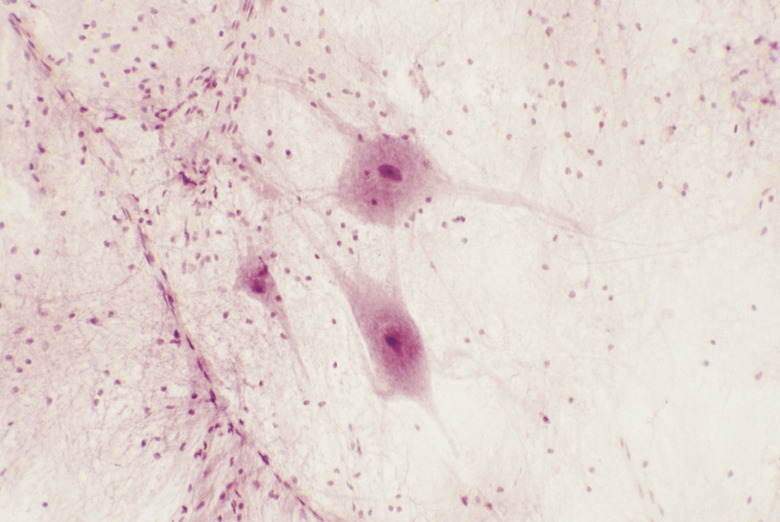Similarities Between Skin Cells & Nerves
Scientists have long been unable to do some types of medical research on living human brains and nerve cells, because it would require removing them from the body. Recent discoveries have yielded methods for taking other kinds of cells, such as skin cells swabbed from the inner cheek, and causing the cells to revert back to their embryonic, stem cell states.
Stem cells can become any kind of cell in the body, and scientists can edit their DNA to turn them into whatever type of cell they want. For example, researchers have been able to use this method to grow human brain tissue in petri dishes with the goals of advancing knowledge of the brain and curing serious neurological diseases.
In the near future, former skin cells may be implanted in people with Huntington's disease or Parkinson's disease without worry of rejection. Although they are no longer skin cells, it is worth considering how nerve cells are similar and different to skin cells.
Cells in the Skin
Cells in the Skin
The skin stretches over almost all of the human body, similar to many other animals. Its functions include providing a barrier, regulating temperature and providing touch sensation. The three layers of skin are:
- Epidermis
- Dermis
- Hypodermis
The epidermis is the outermost layer, and the thinnest. There are three types of skin cells in the epidermis:
- Squamous cells
- Basal cells
- Melanocytes
The body continuously sheds squamous cells and regenerates new ones. At the lowest layer of the epidermis are the basal cells and the melanocytes. The melanocytes make a molecule called **melanin**, which gives skin its color.
The Two Deeper Layers of Skin
The Two Deeper Layers of Skin
Below the top layer is the dermis, which contains many kinds of cells, including nerves, glands, hair follicles and blood vessels. When you sweat or bleed or grow hair, it comes from the dermis. The dermis contains sensory receptors for pain and touch, so whenever you feel something with your skin nerves, your dermis is responsible for that.
The deepest layer of skin, the hypodermis, also known as the subcutaneous fat layer, is the thickest. It consists of fat and a substance called **collagen**, which is a type of stretchy connective tissue that holds everything together.
Basic Anatomy of a Nerve Cell
Basic Anatomy of a Nerve Cell
Nerve cells, or neurons, are nervous tissue cells in the brain, spinal cord and peripheral nervous system. Neurons receive chemical signals from neighboring neurons with branchlike protrusions called dendrites.
This causes an electrical signal to be conducted down the neuron's **axon,** which is a long stalk. At the end, neurotransmitters are released from protrusions called axon terminals for the next neuron to receive. On each neuron is a rounded cell body called the soma, which houses the nucleus and other organelles.
Which Cell Organelle Is Absent in Neuron?
Which Cell Organelle Is Absent in Neuron?
Neurons have almost all of the standard parts of an animal cell. The only organelle they are lacking is the **centriole**, required for cell division. Neurons cannot divide, so when there is damage to the nervous system, it is usually permanent or long-lasting.
Skin cells do have centrioles. Skin faces the harshness and dangers of exposure to the outside world. If skin cells did not divide and regenerate, wounds could not heal.
Nerves and Skin in the Brain
Nerves and Skin in the Brain
Both skin cells and nerves are in the brain. The brain's empty spaces (ventricles) are filled with cerebrospinal fluid (CSF), which circulates throughout the nervous system, bringing nutrients to the cells and removing waste.
Epithelial cells line the ventricles. These cells have rows of projections called **cilia** that propel CSF through the ventricles and into the nervous system.
Similarities in Cell Communication
Similarities in Cell Communication
Many types of glands are present in the dermal layer of skin. The endocrine glands are groups of epithelial cells that release hormones. The endocrine system is a fundamental communication system in the body for regulation of many processes.
Neurons also employ chemicals for communication. They release neurotransmitters as a means of communication for all functions of the nervous system, which controls virtually everything that happens in the body.
Both types of cells are integral for communication, which allows countless functions to be possible in the body.
References
Cite This Article
MLA
E., Rebecca. "Similarities Between Skin Cells & Nerves" sciencing.com, https://www.sciencing.com/similarities-between-skin-cells-nerves-22811/. 27 June 2019.
APA
E., Rebecca. (2019, June 27). Similarities Between Skin Cells & Nerves. sciencing.com. Retrieved from https://www.sciencing.com/similarities-between-skin-cells-nerves-22811/
Chicago
E., Rebecca. Similarities Between Skin Cells & Nerves last modified August 30, 2022. https://www.sciencing.com/similarities-between-skin-cells-nerves-22811/
